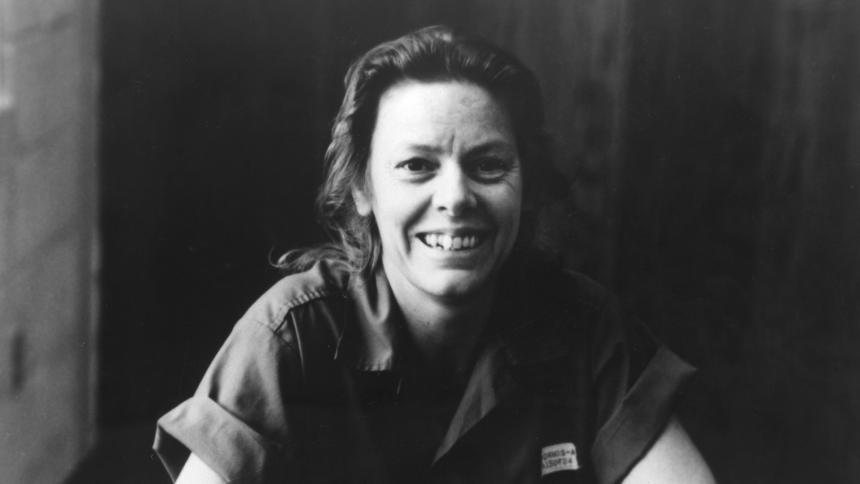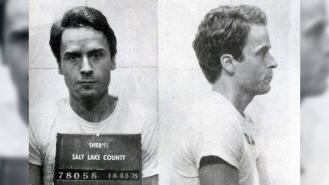
The Damsel of Death: The trial of Aileen Wuornos
Available on Crime+Investigation, Very Scary People (S1, E7) investigates the crimes of Aileen Wuornos who killed seven men over the period of a year by shooting them at point-blank range.
Between 1989 and 1990, the bodies of six men were discovered shot dead in various locations throughout central Florida. Some were found in wooded areas while others were found on dirt roads. They had all been robbed and killed by Aileen Wuornos, the United States’ most infamous female serial killer. In total, she killed seven men, one of whom was never found.
Wuornos was a transient sex worker living out of motels with her girlfriend, Tyria Moore. She would stand along a lonesome stretch of Florida interstate, waiting either for her next client or her next victim. Sometimes, she offered her services. Other times, she claimed her car had broken down and needed a lift. She became known as the 'Damsel of Death'.
On 9th January 1991, Wuornos was arrested after being the subject of a nationwide manhunt. She and Moore had been witnessed walking away from a wrecked car in Marion County. The car was identified as belonging to Peter Siems, one of the murder victims. Inside the car, police found Wuronos’ fingerprint. (Indiana Gazette, 17 January 1991 – ‘Woman Linked to Murders; Police Foresee More Charges’) More evidence linking Wuornos to the seven murders was uncovered following her arrest; property belonging to the seven men was found in a storage unit that she had rented. (Ashbury Park Press, 1 September 1991 – ‘The Country’s First Known Female Serial Killer’)
Following Wuornos’ arrest, she had no qualms about admitting to what she had done. However, she claimed self-defence, stating: 'Sure I shot them, but it was self-defence. I’ve been raped 12 times in the last eight years and I just got sick of it. So, I got this gun and was carrying it around. As soon as I got the gun, it got worse.' While at first investigators speculated that Moore may have been involved in the murders as well, Wuornos completely denied this, and Moore eventually became the star witness during the murder trial.
In January 1992, Wuornos stood trial for the murder of Richard Charles Mallory, her first victim. The case had amassed a large following because female serial killers were largely unheard of.
Mallory was described as a 'temperamental loner' who had a penchant for strip bars while Wuornos was described as a 'prostitute with a checkered past'. Somewhere along the seedy strip of bars between U.S. Highway 1 and Interstate 4, this unlikely duo crossed paths. It was their first and last meeting. 13 days later, on 30th November 1989, Mallory’s body was found, shot to death in woodland near Ormond Beach. (The Orlando Sentinel, 12 January 1992 – ‘Wuornos Trial Has Tabloid TV Flavor’)
During opening statements, defence attorney Tricia Jenkins laid the groundwork for the self-defence argument. She said that Mallory – who was Wuornos’ seventh client of the day – had brutalized her and she finally snapped. 'She defended herself,' /Jenkins said. 'Not one more time. Not one more time.' She said to the jury that Mallory had spent the day drinking vodka and smoking marijuana. (Fort Worth Star-Telegram, 16 January 1992 – ‘Self-Defence is Plea of Damsel of Death’)
Prosecutors, on the other hand, portrayed Wuornos as a ruthless serial killer, with State Attorney John Tanner telling the jury: 'Aileen Wuornos was a predatory prostitute. She was a woman whose appetite and lust for control had taken a lethal turn.'
He said that Wuornos was angry because she believed that Mallory was not going to pay her for her sexual services, suggesting that she grabbed a nine-shot, 22-caliber pistol and shot Mallory as he sat in the driver’s seat. He managed to crawl out the door, but Wuornos opened fire, hitting him at least four more times. Prosecutors revealed that when Wuornos confessed to the murder of Mallory, she offered several versions of what had taken place. (Waterloo Region Record, 16 January 1992 – ‘Female Killer Tells of Lust for Power Over Men’) She had claimed that after a night of drinking and sex, Mallory had become 'violent' and they started to fight over her purse.
The lead witness of the trial was Tyria Moore. She told the jury that while she and Wuornos were watching TV, Wuornos confessed that she had killed a man who she had picked up for sex. She produced a photograph of Mallory and showed it to Moore. According to Moore, Wuornos expressed no remorse and did not say that Mallory had beaten or abused her, nor did she explain why she had killed him. (Fort Worth Star-Telegram, 17 January 1992 – ‘Ex-Lover Says Woman Described First Killing’)
In a rare move, the judge ruled that prosecutors could enter evidence about the six other murders Wuornos had confessed to, including a videotaped confession. At one point during the confession, Wuornos said: 'Maybe it was self-defence, maybe it was just stupid, just off the wall. Shoot, maybe I could have got away with it. Maybe, I mean, got away from them (the victims). I feel guilty. I am guilty. I'm willing to pay the punishment for that.' (UPI, 23 January 1992 – ‘Jury Hears Part of Accused Serial Killer Confession’)
Prosecutors had wanted to shatter Wuornos’ self-defence claim by showing that she had killed six other men in the same methodical manner. Each victim had been killed with the same weapon, and some had been shot in the back. As prosecutors said, the wounds did not bear the hallmarks of self-defence. (Ocala Star-Banner, 22 January 1992 – ‘Prosecutors Focus on Wuornos’ Gun’)
The loved ones of all seven victims were called to the witness stand by the prosecution, not only to humanize the victims but to identify items that were found inside the storage unit. (The Orlando Sentinel, 22 January 1992 – ‘Wuornos Trial Turns Poignant’) They went on to detail what their family members had been doing on the day that they encountered Wuornos and poke holes in the claims of self-defence.
While it was never mentioned during the trial, Mallory had a history of sexual violence; he had been convicted of attempted rape. All the other victims during the trial were described by their family members as hard-working, honest, family men. They had come from varying walks of life.
Richard Mallory was an electronics store owner. David Spears was a construction worker. Charles Carskaddon was a rodeo worker. Peter Siems was a retired merchant seaman. Troy Burress was a sausage salesman. Charles Humphreys was a retired Air Force major and police chief. Walter Antonio was a trucker, security guard, and reserve police officer.
The jury also heard from Bobby Lee Copas, who said that he had picked Wuornos up in November 1990. She told him her car had broken down and she needed to get to Daytona to pick up her children from daycare. During the car ride, he said that Wuornos propositioned him three times. 'Up to that point she had been a perfect lady and as far as I knew, she was just a woman in distress.' (UPI, 22 January 1992 – ‘Motorist Recounts Encounter with Accused Serial Killer’)
However, when he refused her advances, she became irate. She told him she needed $100, and he tricked her into getting out at a gas station, claiming he needed to call his sister. When she got out of the car, Copas locked the door. He told the jury she then yelled at him: 'I’ll kill you like them other fat sons of bitches, Copas. I’ll get you, you son of a bitch!'
His testimony was followed by one from James Della Rosa, who had a similar experience with Wuornos.
After the prosecution rested their case, the defence began theirs. They called only one witness: Aileen Wuornos. She said that Mallory had raped her and tied her up. According to Wuornos, she had agreed to spend the evening with him in a wooded area where things escalated. She claimed that she had never mentioned the rape or assault during her confession because investigators interrupted her, adding that she only admitted to the murders to clear Moore as a suspect. (UPI, 24 January 1992 – ‘Accused Serial Killer Only Defence Witness at Her Trial’)
The crux of the case truly hinged on whether or not the jury believed that Wuornos had acted in self-defence. Ultimately, the jury sided with the prosecution and found Aileen Wuornos guilty of the murder of Richard Mallory. They deliberated for just one hour and 35 minutes. (Akron Beacon News, 28 January 1992 – ‘Florida Hooker is Found Guilty of Felony Murder in Man’s Death’) The jury then recommended unanimously that Wuornos be sentenced to death. The judge agreed with their recommendation. Before the sentence was handed down, Wuornos said to the judge: 'I had no intentions of killing anyone. I told you I was raped, and that’s what happened. I did what I had to do to protect myself.' (The Hamilton Spectator, 1 February 1992 – ‘Highway Prostitute to Die in Florida’s Electric Chair’)
In March 1992, Wuornos pleaded no contest to the murders of Charles Humphreys, Troy Burress, and David Spears. She said that she wanted to be executed as soon as possible, to get away from what she described as 'a crooked, evil planet'. (The Tampa Tribune, 1 April 1992 – ‘Killer Pleads no Contest in 3 Slayings’) Wuornos received three more death sentences.
Wuornos subsequently pleaded guilty to the murders of Edmund Carskaddon and Walter Antonio, receiving two more death sentences as a result. She was never charged with the murder of Peter Siems because his body was never found. She later recanted her claims of self-defence, stating she had been motivated by money. In a later interview with Nick Broomfield, however, she claimed she withdrew her self-defence story simply because she was fed up with being on death row and desired to be executed.
On 9th October 2002, Aileen Wuornos’ wish to die was granted. At 9:47am, she was pronounced dead after a lethal injection, making her the 10th woman to be executed in the United States since the death penalty resumed in 1976.
Her last words were: 'Yes, I would just like to say I'm sailing with the rock, and I'll be back, like Independence Day, with Jesus. June 6, like the movie. Big mother ship and all, I'll be back, I'll be back' (Associated Press, 9 October 2002 – ‘Fla. Executes Female Serial Killer’).
Very Scary People, chronicles the twisted lives of some of the most frightening, diabolical characters in recent history. Hosted by Donnie Wahlberg the series looks at the horrific killings of Charles Manson, Aileen Wuornos, John Wayne Gacy, the Rev Jim Jones, and many others.










